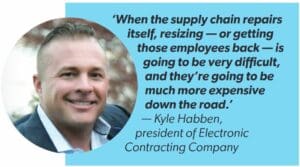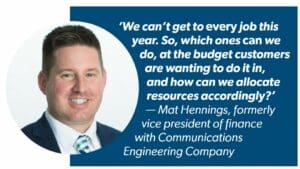At a time when integration businesses are being buffeted with unprecedented challenges, maintaining project profitability is more important than ever before. As Chuck Wilson, CEO of NSCA, said during a recent Commercial Integrator/NSCA webinar, “We don’t do anybody any good if we’re out of business.” That presentation, entitled Preserving Project Profitability in 2022, attracted more than 200 registrants on August 16, all of them eager to learn best practices about how to keep their business in the black. Kyle Habben, president of Electronic Contracting Company, and Mat Hennings, formerly the vice president of finance with Communications Engineering Company, joined Wilson for the one-hour webinar. Although the program is available for download on CommercialIntegrator.com, we’ll here summarize some of the key advice that our presenters offered.
Integrators Should Be Choosy
The panel kicked off with unanimous agreement that integrators must be much more selective as regards the projects they undertake. “It’s a hard concept to say no — especially for the salespeople in us,” Wilson acknowledged. “But it just doesn’t make sense sometimes to have that risk/reward proposition be out of whack.” That’s likely to be the case if the customer views integrated AV as a mere commodity and expects your firm to work at razor-thin margins. “Low-margin work, right now, in this market, is not healthy for the business,” Habben said forthrightly. “When we take low-margin work, especially with the shortage of labor right now, we’re robbing resources from more profitable work and putting them to projects that don’t have the [same] amount of profit in them.” And when otherwise highly profitable projects are starved of resources, their profitability can similarly drain.
View Archive: Preserving Project Profitability in 2022
Hennings articulated a point that NSCA has made for years: Integrators should recognize the value of their work. “We don’t take as much pride sometimes in the product that we’re offering and our value that we’re bringing to this partnership,” he lamented. It’s equally important, however, for clients themselves to be mindful of the real value that integrators deliver; that thought underpins Habben’s view that integrators should choose clients whose goals and vision align with their own. Or, as Hennings put it, it’s not only about the right job but also about the right customer. And then, when you’ve found a client with whom you can build a real relationship, the goal should be to “get sticky” with them. Hennings described this as “a lifetime value conversation.” That’s a very different approach from trying to “buy” a low-margin job on the bid market.
Eyes on Margins
Our panelists also agreed that integrators today must be mindful of margins from the earliest project-ideation stages. Hennings, for instance, urged webinar attendees to set minimum-margin thresholds from a quoting standpoint. “That protection is very key,” he opined. Integrators have always had to be margin conscious, but it has become existential in the last couple of years because of price instability. “We’ve seen probably a 400% increase in price books,” Hennings stated. “We’re getting them monthly…weekly…whereas, in the past, you might get a price book once a year.” The challenge, therefore, is both simple and enormous: Quoting at a margin does not mean it’s possible to execute at that margin six, nine or 12 months down the line. The cost of materials and labor is a moving target, and integrators must be proactive in ensuring they have enough room to execute on a project profitably, regardless of the timeline involved.
Watch: Revenueify on Helping Integrators Achieve RMR
Habben’s viewpoint is that we’re living in unprecedented times. “There are so many things to consider, and margin is incredibly important,” he remarked. Accordingly, Electronic Contracting Company is raising minimum margins due to the various factors contributing to uncertainty (e.g., labor rates, inflation, surcharges, freight costs). But he hastened to add that it’s not just about setting proper margins but also about understanding your costs so you can maintain those margins. As Habben explained it, “I’d recommend something as simple as reviewing the income statement and making sure that you’re job costing what needs to be job costed. People aren’t necessarily putting everything above the line that needs to be above the line so that you’re understanding true cost.” NSCA offers integrators business resources that are useful in ascertaining a project’s true cost.
Labor Utilization and Efficiency
When integrators think about a project’s cost, it’s essential to consider not only labor utilization but also efficiency. This entails situations like, as Wilson described, “When everybody’s standing around, waiting for something to happen, or there are multiple trips to the project.” These days, it’s harder than ever to keep labor-utilization rates at 75% or 80% plus because supply-chain snarls have brought some projects to a standstill. According to Habben, with many integrators having backlogs well into the millions, they find themselves both overstaffed and understaffed. There might not be enough work to keep everyone busy right now, he acknowledged. However, he added, “We need those resources so that, when we do get parts, we can burn through that backlog.” Given integrators’ historical challenges with cashflow, business owners face difficult decisions.
All panelists agreed that it’s an excellent time to invest in getting team members trained and certified, inclusive of both association and vendor offerings. “In the last 12 months, we’ve probably invested more in training than we have in the last five years combined,” Habben enthused. Indeed, he reported more than 30 team members earning CTS certification, as well as attaining numerous vendor certifications. “What we can do is be more prepared to be successful, and to put those people in a position to be successful when they get back, busy, and start running work,” he added.
Sharpening the focus, Wilson suggested integrators direct their training efforts to specific tasks that pertain to upcoming projects; doing so, he said, will increase efficiency on the tail end of those jobs. Hennings echoed that point, rhetorically asking, “What big jobs are upcoming? Maybe you need to train on specifics related to that job. So, when you hit the ground running, that team is ready to go.”
 Taking a wider view, the panelists encouraged attendees to be more intentional in running efficient, financially sound businesses. “As a job is going on,” Hennings began, “what’s the Estimate to Complete? What’s left to do on the job? Bump that up against your actuals of what you’ve already spent and see how the job is performing.” Zeroing in on the topic of labor, he urged integrators to be aware of standard times to complete project tasks. “Are we performing?” Hennings asked rhetorically. “Or are we overing those jobs, where two folks are going to every task that should only take one?”
Taking a wider view, the panelists encouraged attendees to be more intentional in running efficient, financially sound businesses. “As a job is going on,” Hennings began, “what’s the Estimate to Complete? What’s left to do on the job? Bump that up against your actuals of what you’ve already spent and see how the job is performing.” Zeroing in on the topic of labor, he urged integrators to be aware of standard times to complete project tasks. “Are we performing?” Hennings asked rhetorically. “Or are we overing those jobs, where two folks are going to every task that should only take one?”
As part of an effort to drive efficiency at his company, Habben recently created a general foreman role to liaise between project managers and leads in the field. That role, he said, centers on what’s being done each day and the quality of the work performed. “You need to be looking at utilization and chargeability versus overages and trying to keep an eye on where you’re at,” Habben advised.
Turning to Subcontracted Labor
At a time of increasing labor costs and uncertain project timelines, subcontracted labor has become a more attractive option for many integrators. It’s a prerequisite, of course, for firms to properly vet their subcontractors — namely, to perform background checks, ensure they adhere to proper installation standards and have them sign solid agreements. As Wilson stressed, “We have to be fully responsible for our subcontractors we bring onto the job site.” But assuming your firm checks those boxes, this can be an avenue to meaningfully boost revenue.
“Our philosophy here is supplementing our existing workforce with subcontractors will help us widen the pipe, so to speak, so we can recognize more revenue in any given month and burn through more of that backlog,” Habben declared. Just as importantly, subcontractors can bring unique skill sets that genuinely bolster an organization’s abilities. “In many cases,” he acknowledged, “depending on their specialty, subcontractors can perform work more efficiently and more profitably than we can.”
Related: Looking Beyond Labor & AV Industry Changes with Herman
Hennings echoed Habben’s enthusiasm for subcontracted labor, saying, “I think that is a very good avenue, where you can continue to drive [revenue]. And, again, if you don’t have the work or can’t get to the work, you don’t have to continue to pay those folks.” Another option, Hennings said, is temp labor. He rhetorically asked webinar attendees if the staffers they’ve invested in and coached up can lead a crew of temp laborers. If so, he added, going that route can almost be akin to instituting a technical internship program. As Hennings described it, “If you’ve got some of those temp laborers who have proven themselves, well, now, you don’t have to go out, interview folks and take a guess.”
All that being said, however, the panelists sounded a note of caution for integrators considering downsizing their in-house workforce during these difficult times. Cashflow remains top of mind, and, yes, some integrators have contracted in recent months. But, according to Habben, “My fear is, when the supply chain repairs itself, resizing — or getting those employees back — is going to be very difficult, and they’re going to be much more expensive down the road.” Thus, it might make more sense to view subcontracted and temp labor as additive resources to drive revenue, as opposed to substitutionary resources. Wilson closed with another word of warning, urging integrators to closely read the terms and conditions of client contracts. Some of them explicitly disallow temporary labor.
Protective Contract Language
Continuing on the topic of contracts, Wilson offered essential advice to allow integrators to protect themselves in these challenging times. He started by referencing force majeure language that NSCA has crafted in consultation with other experts. “It gives you some protection about the availability of products that are outside of your control,” he said. What’s more, NSCA has developed language for a waiver of delivery and a waiver of usage of the technology in a permanent, completed state. If the GC or owner accepts that language, Wilson explained, it would alleviate problems stemming from liquidated damages clauses. That, therefore, would protect integration businesses if materials are not delivered in the timeframe within which your firm pledged the system would be up and running. “We’ve helped significantly with that type of language,” Wilson noted.
It’s essential to ensure quotes, proposals and contracts are not undercutting your firm’s potential for profitability. That’s why, Wilson said, “We’re starting to see more and more of our members that are pulling old quotes off the street.” In fact, he remarked, a large member company pulled back 400 proposals. One change being made across the board is dramatically decreasing the validity period for quotes. “We’ve backed ours down to 30 days, and we’re toying with the idea of taking that down to 14 or 15 days to protect our business,” Habben said frankly. A quote with a 90-day lifespan can be a recipe for disaster because, he emphasized, “Your costs are going to go up.” This aligns with Wilson’s exhortation for integrators to be “…protecting ourselves from the uncertainty of the surcharges and the price increases and all that.”
It’s not just force majeure language and expiration dates, though; protective language can extend far beyond those. According to Habben, his firm has added a chip-shortage clause. Moreover, he’s sought to insert contract language to protect integration companies in the event of jobsite trips where the integrator can’t get in. Equally important, integrators should review their protective language frequently — perhaps every month — to assess whether novel situations might compel language revisions. “It’s very critical, I think, that anybody in this business is monitoring [things] very closely,” Habben advised. “It’s an ever-changing situation.”
Maintaining Strong Client Relationships
“Our customers are what keeps the lights on,” Habben observed. “They’re what keeps the door open.” That’s why, foremost above all, integration business owners must cultivate and protect strong client relationships. According to Hennings, most customers “get it” that we’re living in a period with high product demand and low component supply; even so, it’s imperative for integrators to keep communication open and honest. “Build into that quote document some language on the proposal side,” he suggested. “[Like,] ‘these are the things we’re experiencing.’ Make sure the customer is aware of it.” In fact, Hennings floated the idea of putting a bucket of “contingency funds” in your quote — some padding to preclude having to return to the client and retroactively increase their cost. Amplifying that point, Habben added, “Trying to build that number on the frontend, so we don’t have to have those uncomfortable conversations is, I think, better practice.”
But for NSCA-affiliated integrators like Habben and Hennings — business leaders whose stock-in-trade centers on long-term, trust-based relationships — having frank conversations with customers might be easier than one would imagine. The key is to understand the discussion as one element of strategically planning which projects your firm is going to run with. For Hennings, that means “…consciously having that right conversation. Being upfront about what it’s going to cost with this finite resource pool — both on the product side and people. We can’t get to every job this year. So, which ones can we do, at the budget customers are wanting to do it in, and [how can we] allocate resources accordingly?”
Adhering to Core Values
Part of serving your customer well, Wilson said, is rejecting advice occasionally given by vendors to “bury” surcharges and price increases in labor costs. “My advice is, don’t listen to that,” he said with conviction. “Listen to your own code of ethics and your business best practices — your core values. Listen to that, rather than people who are just trying to make an easy sale.”
Equally important, Wilson implored, is not to be one of those integrators sitting at a project-kickoff meeting, secretly knowing your firm isn’t going to make any profit on that job. Instead, find clients who recognize the art and science of AV integration and who value your firm’s expertise. Find customers who are seeking a long-term relationship, rather than a simple, one-time design-and-installation gig. “Our mindset as solution providers,” Wilson concluded, “is really to focus on what happens after that.”











